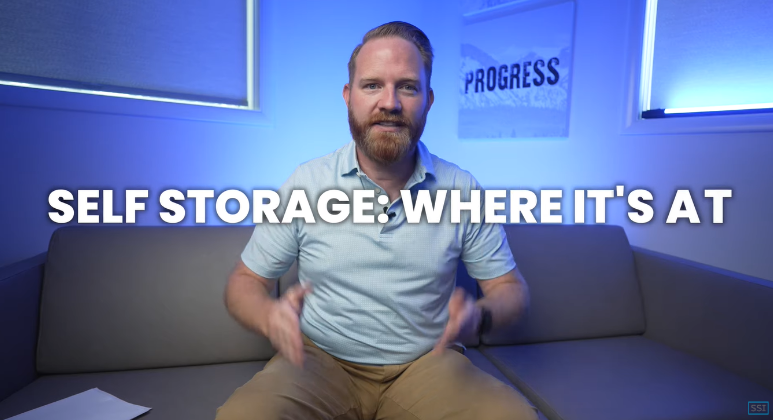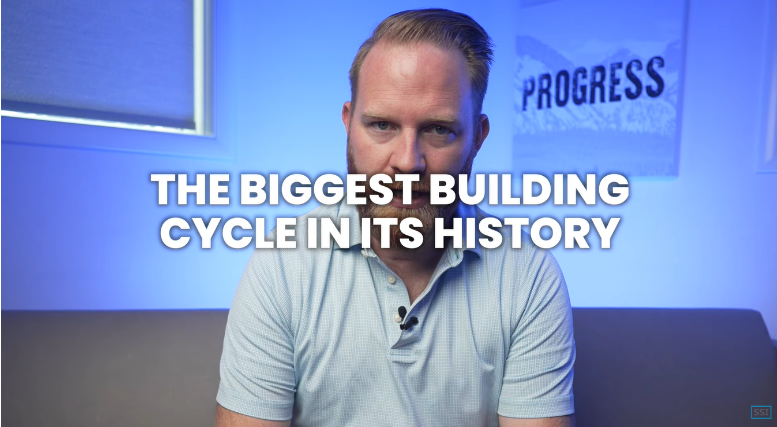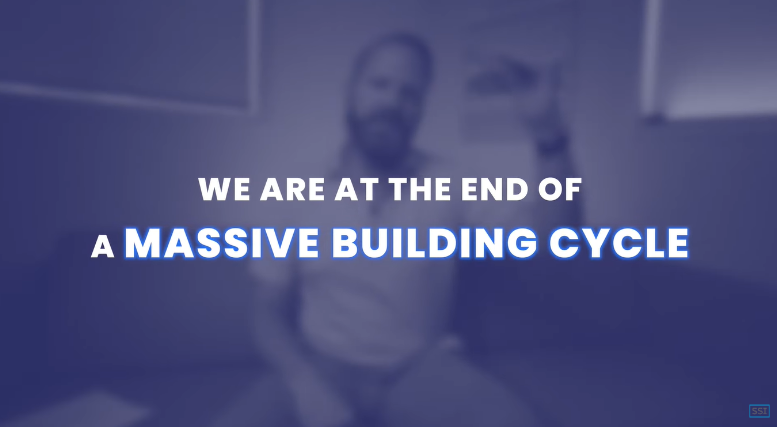
Self-Storage: How it Became an Amazing Real Estate Asset
Sep 22, 2023Today's topic is all about self-storage. We’ll take a look back at the industry’s history to help us predict where it’s headed as well as focusing a bit on where it's at in today's market. We'll dive into the risks and chances it offers. This is seriously crucial to grasp, especially now. This might just be one of the most significant topics I'll ever discuss.
Evolution of Self Storage: From Obscurity to Mainstream Real Estate Asset
Self-storage technically got its start in the 60s. During the 70s, it was still a fledgling asset category. In the beginning, not many knew about it – it was just a handful of developers and individuals who began creating this kind of asset. When you first looked at them nobody thought that made a lot of sense. It's a box, it doesn't matter.

It started gaining ground during the 80s, but it was in the 90s when it really took shape and became an actual real estate asset class. Though in the early 2000s, it shifted from being an alternative to a more traditional alternative asset.
When we first jumped into this, we were snagging properties with yields upwards of eight percent, and sometimes even at 11 or 12 percent. But banks weren't keen on it, and people didn't quite get it. Getting financing was tough, because it wasn't seen as a secure investment. Lots of folks doubted the survival of this asset; they saw it as a passing fad that would vanish.
During that era, these assets behaved quite differently from one another. However, some folks were reshaping their appearance and feel. This transformation was mainly happening in top-tier locations like California, New York, and certain parts of Florida. They were constructing high-end self-storage facilities, geared more towards institutional use.
The Unexpected Rise: How Self-Storage Became a Standard in Real Estate
Back when you first laid eyes on those self-storage units, it's not like anyone was thinking, "Wow, that makes perfect sense!" I mean, it's just a box, right? But today, it's become the norm in pretty much every market, big or small. People are willing to pay for that difference, and customer expectations have shifted.
So, how did all of this come about? How did we get here? Well, let's rewind to the time before the great recession. It's crucial to know that self-storage hadn't really gone through a booming development phase. Sure, there were facilities being built in the early 2000s, but it wasn't like the typical assets you'd see. We hadn't hit that point where the demand absorbed the supply, and here's why:
First off, big institutions weren't keen on diving into this scene. Why? Well, it's a management headache. Nobody had a clear idea of how to handle it. The leases were short-term, folks were in and out all the time – a total management nightmare. And guess what? There weren't any third-party management companies around to swoop in and save the day.
Navigating Self-Storage Investment: From Challenges to Tech-Driven Success
Imagine you're a bank, a big investor, a fund, or just about anyone interested. You're thinking, "Yeah, I should totally buy into this self-storage thing." But hold on, there's a catch – a whole bunch of complications waiting to be dealt with.
Then there's this other part of the story. You see, those fancy models that are supposed to predict how things will fare in economic turmoil? Well, they couldn't quite figure out if self-storage could survive a major economic crash. And that meant Wall Street folks were hesitant to pour their money into it. If my model can't tell me how this thing will hold up during a financial crisis, why would I risk my capital on it?
Now, let's rewind to just before 2008. There was this company called Extra Space, and sure, there were a few third-party management companies floating around, but nothing major, nothing standard, especially for the big players and funds. But then the financial crisis hit, and guess what? Extra Space stepped up to the plate. They started leading the charge in the third-party management game.
And here's the kicker: they did it with tech. They used it to run things smoothly, market themselves like pros, and rake in profits – all through the magic of the internet. Thanks to their tech prowess, Extra Space became the go-to name in third-party management. They basically rocked the whole industry.
From the mess of complications to riding high on technology, Extra Space turned the self-storage world on its head.
Rise of Self-Storage: Weathering Crises and Capital Shifts
So, what went down after 2008? Well, we had ourselves a real doozy – the great recession, a massive credit crisis that only rolls around once a century. And guess who weathered the storm like a champ? Yep, you got it – self-storage. Storage outperformed all other types of real estate.
 Because of this success, big players started noticing. They realized that self-storage had a solid, dependable model. It sailed through the stormy waters of the crisis with its head held high. And the best part? It could run without needing constant on-ground attention. That's when things began to accelerate – the self-storage boom was born.
Because of this success, big players started noticing. They realized that self-storage had a solid, dependable model. It sailed through the stormy waters of the crisis with its head held high. And the best part? It could run without needing constant on-ground attention. That's when things began to accelerate – the self-storage boom was born.
Now, this boom wasn't solely due to the 2008 situation. It was also a result of something else going downhill – and that set off a whole new chain reaction. But let's fast forward to more recent times. The past year or so in the world of self-storage has been quite the ride, and we'll talk about that in a moment.
So, what happened after 2008? Well, some other investment darlings took a major hit. I'm talking about those golden geese of the investment world – single-family homes and retail spaces. These were thought to be as secure as government bonds, but these things change. Retail centers that used to house big names like Sears and Kmart suddenly turned shaky. Commercial real estate's value hinges on stable revenue, and that stability crumbled for retail. People started doubting if the cash flow would still be around in a decade. Trust tanked, and a lot of folks sought alternatives. Guess where some of that capital headed? You guessed it – self-storage.
Reshaping Real Estate: Self-Storage's Journey Amidst Chaos
Fast forward to 2021. Let's take a peek at the real estate scene. We've got housing, which took a hit during the credit crisis but managed to stay afloat. Then there's the whole saga with hotels, retail spaces, and office buildings. They're all facing uncertainties about their future performance. Some of them might be on their last legs – think abandoned malls and such. And this has all unfolded in just 15 years. Talk about a total real estate rollercoaster.
But guess who emerges from the wreckage like a phoenix rising from the ashes? You got it – self-storage. In the midst of this real estate turmoil, self-storage managed to not only survive but thrive. This is a big deal because it doesn't guarantee a smooth ride ahead. Different parts of the real estate world are at different stages of their life cycle. Some are headed downhill, and a few might even vanish. Change is the name of the game here.
Take malls, for instance. They've gone through a major transformation. They're still around, but now they're outdoor spaces serving a whole new purpose. It's a whole different vibe, drawing in a different crowd. So, while these industries aren't wiped off the map, they've definitely evolved into something else. And let's face it, they're not as widespread as they used to be.
In a nutshell, the real estate landscape has been flipped upside down, and self-storage has managed to navigate this chaos with finesse. But hold onto your hats, because the future is anything but predictable. The only certainty? Change is inevitable.
Self-Storage: Riding the Ascendant Wave
Now, picture this: self-storage is on a completely different trajectory. It's in the midst of its most massive building spree ever. We're talking about billions upon billions of dollars being pumped into this.
 To put it in perspective, before 2008, a year might have seen around a billion dollars of investment. But since 2012, we've been cruising past two billion every single year. That's not all – we're talking about four, five, even a whopping 7.5 billion dollars' worth of shiny new storage assets hitting the market. These aren't your run-of-the-mill storage units like those from the past decades. These are swanky, top-tier spaces offering all sorts of services.
To put it in perspective, before 2008, a year might have seen around a billion dollars of investment. But since 2012, we've been cruising past two billion every single year. That's not all – we're talking about four, five, even a whopping 7.5 billion dollars' worth of shiny new storage assets hitting the market. These aren't your run-of-the-mill storage units like those from the past decades. These are swanky, top-tier spaces offering all sorts of services.
Self-storage has basically grown up – it's become a whole new beast. It's matured and transformed into something distinct. But why does this matter? Well, it's all about the future. Now don't get me wrong, I'm not saying self-storage is on the brink of disappearing. Not by a long shot. What I am saying is that the supercharged performance we saw in the past might not be as frequent. We had this steep ascent, but now we're on a different path.
You see, self-storage is still in its early days, especially when you compare it to other types of real estate that have been around for centuries. So, in a nutshell, self-storage is here to stay and keep doing well. It's like this new player in the game that's got a lot of innings left to play.
Navigating Change: Self-Storage in a Maturing Cycle
So, here's the scoop from where I stand: I'm in the midst of developing some massive self-storage facilities. Every quarter, we're snapping up hundreds of thousands of square feet. But here's the twist – things have shifted, and the game has gotten riskier, a lot riskier. Why? Because we're not at the start of a building spree anymore. We're nearing the end of a major cycle.
 Let's flashback to 2008. Back then, the retail and housing markets took a hit because they had overextended themselves in terms of supply. They were pumping out more than there were takers for, and the whole thing crumbled. Retail had been on a wild building ride through the 90s, but that came crashing down, especially with the rise of Amazon.
Let's flashback to 2008. Back then, the retail and housing markets took a hit because they had overextended themselves in terms of supply. They were pumping out more than there were takers for, and the whole thing crumbled. Retail had been on a wild building ride through the 90s, but that came crashing down, especially with the rise of Amazon.
Now, let's jump to today. Self-storage is on the flip side of that coin. We're at the tail end of a building frenzy and let me be clear – I'm not saying self-storage is about to keel over and die. Not at all. It's not going to collapse. But here's the real deal: some markets won't churn out the returns they did before, and in some places, there's just too much self-storage floating around.
This is why knowing where we are in the cycle becomes vital. It also matters to understand the lifespan of self-storage in the bigger picture. This insight guides us in making smart choices right now. So, what's the game plan? 
Well, if you're in the business, you've got to be extra cautious about where you're buying and where you're putting up new facilities. It's not going to be a replay of the past 10 years, and even looming recessions won't have the same impact on self-storage. It's a whole different beast now, and there's a lot more of it out there.
Staying Cautious Amidst Industry Shifts: Self-Storage Insights
Let's paint a scenario – if a 2008-style crisis hit us today, the self-storage industry would be in dire straits nationwide. We're talking about a situation where there's an influx of new facilities across the board, sitting empty while demand takes a nosedive. The message here? It's about treading carefully, being mindful of the shifting landscape, and making strategic moves in this ever-evolving self-storage arena.
You've got to be meticulous in gauging demand, carefully analyzing revenue potential. Will it rise? Will it hold steady? Here's the kicker – alongside this massive surge in supply, we're also sitting at peak valuations and prices. That's the reality we're facing today.
Keep this in mind: not all markets are cut from the same cloth, especially in the self-storage realm. It's all about being hyper-local, meaning there are opportunities lurking everywhere. But let's be clear – there's no guarantee here, just potential waiting to be seized.
Right now, we're constructing in areas that I believe are home runs. I'm also acquiring spaces in locations that haven't seen new builds for ages. And guess what? These spots are poised to perform exceptionally well, and they'll keep doing so for the long haul.
The bottom line is, it's not an impossible feat, and it's not like you can't succeed. What's vital, however, is proceeding with caution. It's about grasping where the self-storage landscape stands in its investment cycle and making informed moves based on that understanding. In this ever-shifting industry, opportunity abounds – you just need to know how to navigate it wisely.


